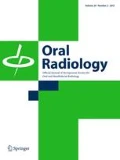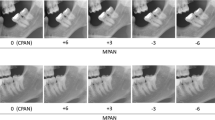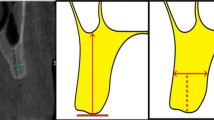Abstract
Objective
To assess the image quality of the mandibular third molar region using different milliamperage (mA) settings of cone-beam computed tomography.
Methods
Twelve dry mandibles with impacted third molars were scanned with a Kodak 9000 unit (Kodak Dental Systems, Carestream Health, Rochester, NY, USA) using different mA settings (2, 4, 6.3, 8, 10, 12, and 15 mA). Two oral radiologists evaluated the images. They classified the tooth root, periodontal space, lamina dura, trabecular bone, mandibular canal, and overall image quality as excellent, good, poor, or inadequate for diagnosis. Statistical analyses were performed by one-way ANOVA with a post hoc Tukey test to investigate the influence of the mA settings in the image quality of the structures analyzed. The significance level was set at 5 %.
Results
The 15 and 12 mA settings provided the highest mean values for all the evaluated criteria, with significant differences from the values for the other mA settings. The 10, 8, and 6.3 mA settings showed no significant differences in relation to tooth root and periodontal space. For the other evaluated criteria, no significant differences were observed for the 10 and 8 mA settings. The 4 and 2 mA settings gave the lowest mean values.
Conclusions
The best low-dose protocol with good image quality was the 10 mA setting. Lower dose protocols with 8 and 6.3 mA settings can also be used for these purposes, but caution is necessary because of increased image noise.

Similar content being viewed by others
References
Loubele M, Van Assche N, Carpentier K, Maes F, Jacobs R, Van Steenberghe D, et al. Comparative localized linear accuracy of small-field cone-beam CT and multislice CT for alveolar bone measurements. Oral Surg Oral Med Oral Pathol Oral Radiol Endod. 2008;105:512–8.
Suomalainen A, Kiljunen T, Käser Y, Peltola J, Kortesniemi M. Dosimetry and image quality of four dental cone beam computed tomography scanners compared with multislice computed tomography scanners. Dentomaxillofac Radiol. 2009;38:367–78.
Ziegler CM, Woertche R, Brief J, Hassfeld S. Clinical indications for digital volume tomography in oral and maxillofacial surgery. Dentomaxillofac Radiol. 2002;31:126–30.
Miracle AC, Mukherji SK. Conebeam CT of the head and neck, part 1: physical principles. AJNR Am J Neuroradiol. 2009;30:1088–95.
Hatcher DC. Operational principles for cone-beam computed tomography. J Am Dent Assoc. 2010;141:3S–6S.
International Commission on Radiological Protection. Recommendations of the International Commission on Radiological Protection. ICRP Publication 103. Ann ICRP. 2007;37:1–332.
Safety and Efficacy of a New and Emerging Dental X-ray Modality. Radiation protection no. 172: cone beam CT for dental and maxillofacial radiology (evidence-based guidelines); 2012. http://www.sedentexct.eu/files/radiation_protection_172.pdf. Accessed 12 Nov 2012.
Ekestubbe A, Gröndahl K, Ekholm S, Johansson PE, Gröndahl HG. Low-dose tomographic techniques for dental implant planning. Int J Oral Maxillofac Implants. 1996;11:650–9.
Zammit-Maempel I, Chadwick CL, Willis SP. Radiation dose to the lens of eye and thyroid gland in paranasal sinus multislice CT. Br J Radiol. 2003;76:418–20.
Cohnen M, Fischer H, Hamacher J, Lins E, Kötter R, Mödder U. CT of the head by use of reduced current and kilovoltage: relationship between image quality and dose reduction. AJNR Am J Neuroradiol. 2000;21:1654–60.
Sohaib SA, Peppercorn PD, Horrocks JA, Keene MH, Kenyon GS, Reznek RH. The effect of decreasing mAs on image quality and patient dose in sinus CT. Br J Radiol. 2001;74:157–61.
Rustemeyer P, Streubühr U, Suttmoeller J. Low-dose dental computed tomography: significant dose reduction without loss of image quality. Acta Radiol. 2004;45:847–53.
Koizumi H, Sur J, Seki K, Nakajima K, Sano T, Okano T. Effects of dose reduction on multi-detector computed tomographic images in evaluating the maxilla and mandible for pre-surgical implant planning: a cadaveric study. Clin Oral Implants Res. 2010;21:830–4.
Lofthag-Hansen S, Gröndahl K, Ekestubbe A. Cone-beam CT for preoperative implant planning in the posterior mandible: visibility of anatomic landmarks. Clin Implant Dent Relat Res. 2009;11:246–55.
Sur J, Seki K, Kiozumi H, Nakajima K, Okano T. Effects of tube current on cone-beam computerized tomography image quality for presurgical implant planning in vitro. Oral Surg Oral Med Oral Pathol Oral Radiol Endod. 2010;110:29–33.
Lofthag-Hansen S, Thilander-Klang A, Gröndahl K. Evaluation of subjective image quality in relation to diagnostic task for cone beam computed tomography with different fields of view. Eur J Radiol. 2011;80:483–8.
Dawood A, Brown J, Sauret-Jackson V, Purkayastha S. Optimization of cone beam CT exposure for pre-surgical evaluation of the implant site. Dentomaxillofac Radiol. 2012;41:70–4.
Panmekiate S, Apinhasmit W, Petersson A. Effect of electric potential and current on mandibular linear measurements in cone beam CT. Dentomaxillofac Radiol. 2012;41:578–82.
White SC, Mallya SM. Update on the biological effects of ionizing radiation, relative dose factors and radiation hygiene. Aust Dent J. 2012;57:2–8.
Qu XM, Li G, Ludlow JB, Zhang ZY, Ma XC. Effective radiation dose of ProMax 3D cone-beam computerized tomography scanner with different dental protocols. Oral Surg Oral Med Oral Pathol Oral Radiol Endod. 2010;110:770–6.
Lofthag-Hansen S. Cone beam computed tomography radiation dose and image quality assessments. Swed Dent J Suppl. 2010;209:4–55.
Sandborg M, Alm Carlsson G, Persliden J, Dance DR. Comparison of different materials for test phantoms in diagnostic radiology. Radiat Prot Dosimetry. 1993;49:345–7.
Conflict of interest
There are no financial or other relations that could lead to a conflict of interest.
Author information
Authors and Affiliations
Corresponding author
Rights and permissions
About this article
Cite this article
Neves, F.S., Souza, T.d.C., de-Azevedo-Vaz, S.L. et al. Influence of cone-beam computed tomography milliamperage settings on image quality of the mandibular third molar region. Oral Radiol 30, 27–31 (2014). https://doi.org/10.1007/s11282-013-0132-6
Received:
Accepted:
Published:
Issue Date:
DOI: https://doi.org/10.1007/s11282-013-0132-6




